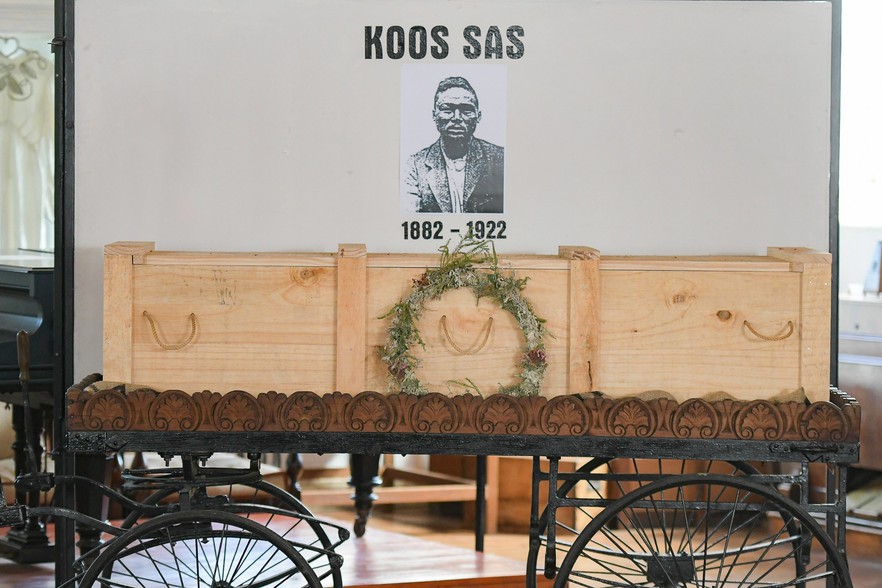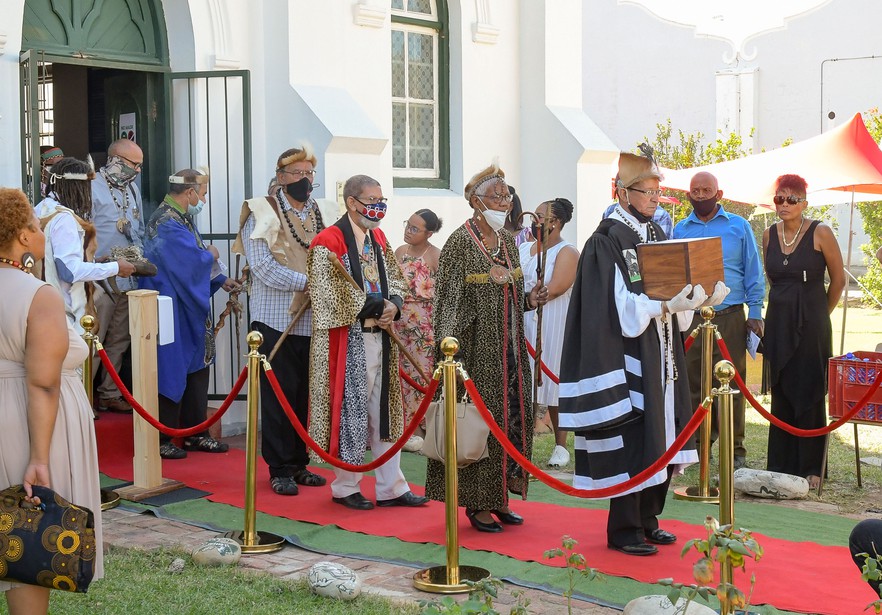The skull of the outlaw hero Koos Sas finally laid to rest
Nearly 100 years after his death, Khoisan leaders ceremonially inter his remains
The skull of Koos Sas, which had been kept in a glass case in a museum, was placed in a casket inside a wooden coffin. Photos: Jeffrey Abrahams
- The skull of outlaw hero Koos Sas, who was shot dead in 1922, was interred near Montagu on 18 April.
- Sas, a sheep rustler, was shot after being accused of murder.
- His skull was kept in the museum at Montagu for years.
- In a ceremony led by Hessequa Khoisan leader Reggie Boesak, the skull was finally interred at the weekend in Cogmanskloof.
A painful chapter in Karoo history was concluded on 18 April when the skull of Koos Sas, who was killed nearly 100 years ago in Springbok, was buried in Montagu in a ceremony conducted by Khoisan leaders.
Sas, a sheep rustler who was accused of murder, is seen as a hero among Hessequa Khoisan.
Hessequa leader and chaplain Reggie Boesak led the procession carrying the skull in its casket.
The skull was placed in a casket and the burial procession moved from the Montagu Museum, where Sas’s skull had been kept on display for years, to Cogmanskloof where it was interred.
The procession moved through the streets of Montagu.
According to official records, Sas was a sheep rustler accused of murdering a shopkeeper, who was the son of the dominee. He was arrested and the trial was transferred to a higher court in Worcester, but before the trial could begin Sas escaped from custody, as he had done many times. He was declared an outlaw, one who had no rights and who was without any legal protection (in Afrikaans “voëlvry”). This was effectively a death sentence that could be executed by anyone.
Five years later, on 8 February 1922, he was spotted in Springbok, some 600km away, and shot. The dominee there had a photograph taken of his body and printed postcards of it, with proceeds going to the Afrikaans Christian Women’s Association. He was later decapitated and his skull ended up in a glass case in the Mission Church Museum in Montagu, with the rifle which had been used in the shooting.
His story was told by musician David Kramer in Die Ballade van Koos Sas, which later became the musical The Last Bushman of Montagu, a title Sas is said to have claimed for himself.
In March, nearly 100 years after his death, the skull of Koos Sas was ceremonially handed back to Reggie Boesak, leader of the Hessequa Khoisan, by provincial minister of culture and sport Anroux Marais in Montagu, removed from the glass case and placed in a casket in a wooden coffin.
The funeral party followed the casket up Cogmanskloof.
To the Hessequa Khoisan, Koos Sas was a hero and a symbol of resistance against their oppressors. His actions, say Hessequa leaders, should be seen in the context of how they as a people were treated. He was sentenced to death, hunted and shot without a trial. The postcard depicting his remains showed that he was not regarded as human and his skull was put on public display as if it were a hunting trophy.
His remains are now interred on a ledge near an overhanging rock in Cogmanskloof. Boesak said the event laid the foundation for forgiveness, reconciliation and peace.
Koos Sas’s skull has finally been interred, on a ledge near an overhanging rock in Cogmanskloof.
Support independent journalism
Donate using Payfast

Don't miss out on the latest news
We respect your privacy, and promise we won't spam you.
Next: Mamelodi residents have waited five years for electricity connections
Previous: Children play in sewage in Gqeberha
© 2021 GroundUp. This article is licensed under a Creative Commons Attribution-NoDerivatives 4.0 International License.
You may republish this article, so long as you credit the authors and GroundUp, and do not change the text. Please include a link back to the original article.
We put an invisible pixel in the article so that we can count traffic to republishers. All analytics tools are solely on our servers. We do not give our logs to any third party. Logs are deleted after two weeks. We do not use any IP address identifying information except to count regional traffic. We are solely interested in counting hits, not tracking users. If you republish, please do not delete the invisible pixel.





